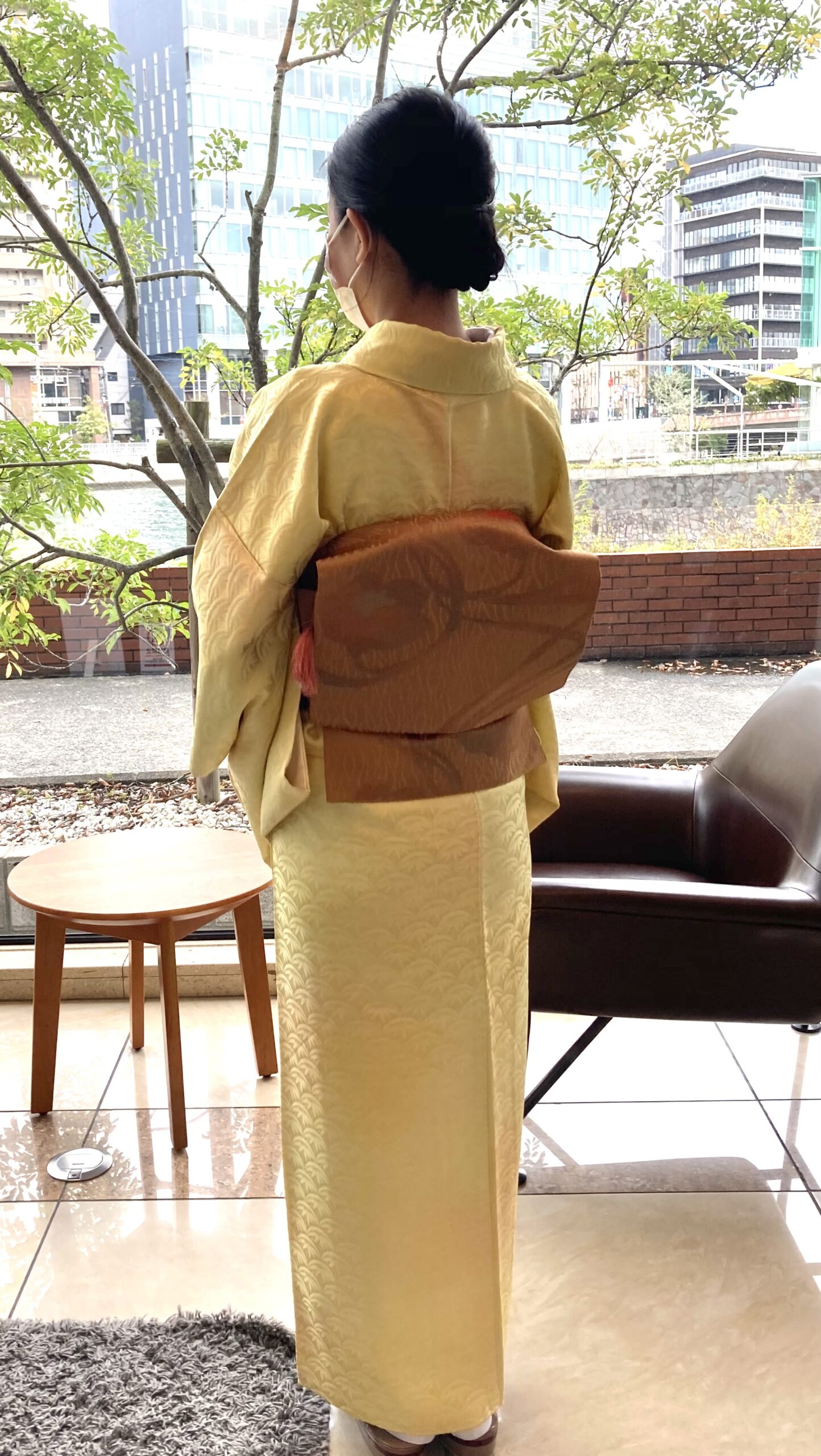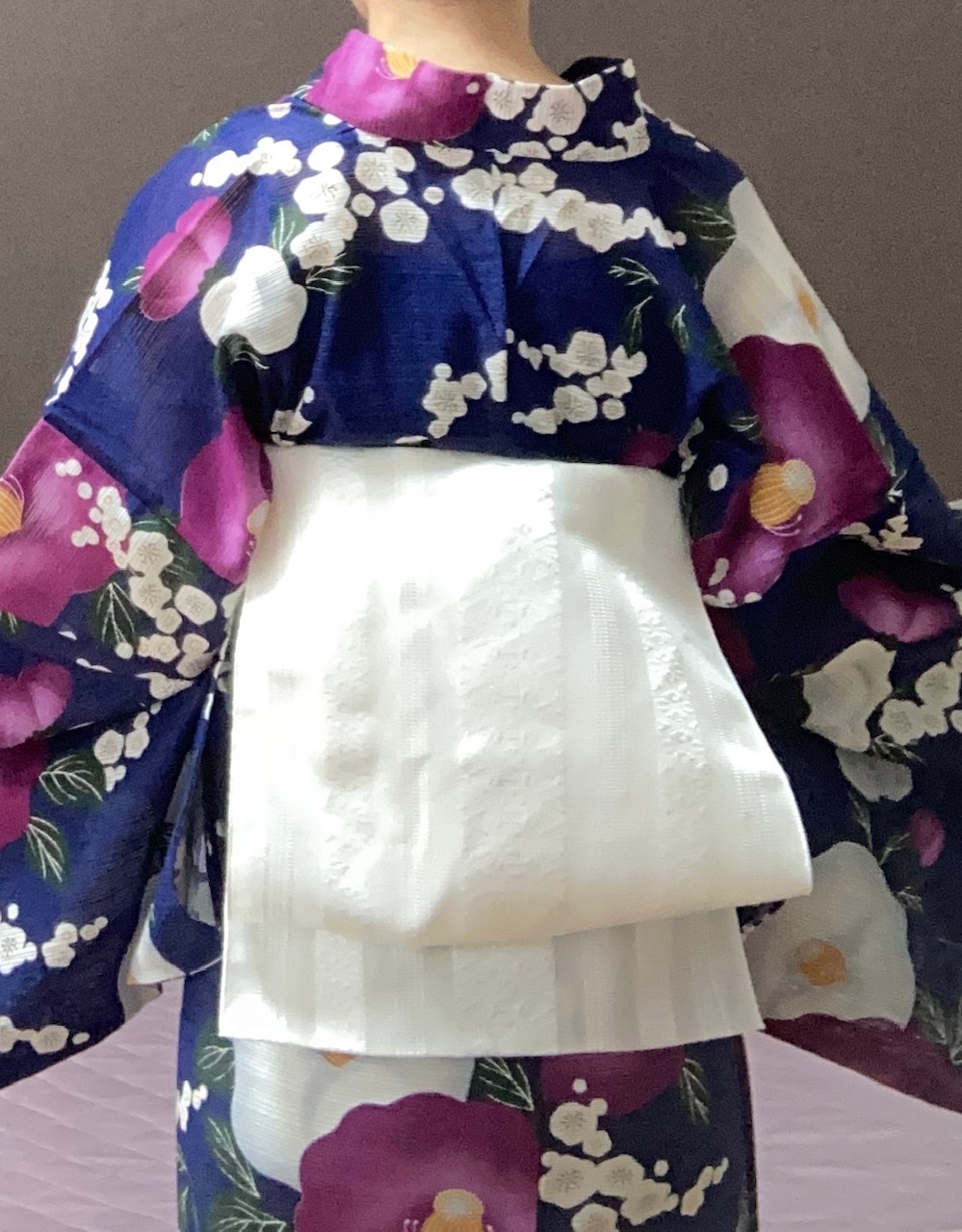Are you intimidated by all the accessories that seem necessary for kimono wearing? Do you feel overwhelmed by the thought of managing obi-age, obi-jime, and obi-makura all at once? You’re not alone in feeling this way!
Many people avoid wearing kimono because they think it requires mastering numerous complicated accessories and tying techniques. The truth is, you can absolutely enjoy wearing kimono without obi-age, obi-jime, and obi-makura!
In this simplified kimono guide, you’ll discover how to wear beautiful kimono using minimal accessories, learn about easy obi options perfect for beginners, and gain the confidence to start your kimono journey without stress or complexity.
- The Common Kimono Misconception: More Accessories = Better Look
- Why Simple Kimono Wearing Makes Sense
- Option 1: The Han-Haba Obi – Your Gateway to Easy Kimono
- Option 2: Simplified Nagoya Obi Styling
- Learning Resources for Simple Kimono Styling
- Simple Kimono Styling: Step-by-Step Approach
- Common Questions About Simple Kimono Wearing
- Building Your Simple Kimono Collection
- The Joy of Simple Kimono Living
- Your Simple Kimono Journey Starts Now
The Common Kimono Misconception: More Accessories = Better Look
When most people picture kimono wearing, they imagine the classic otaiko (drum knot) style with all its traditional accessories. This formal look requires:
- Obi (Nagoya Obi / wide sash)
- Obi-age (decorative silk cord)
- Obi-jime (decorative cord)
- Obi-makura (obi pillow)

No wonder kimono feels intimidating!
But here’s what many people don’t realize: this formal styling is just one way to wear kimono. There are much simpler approaches that are equally beautiful and culturally appropriate.
Why Simple Kimono Wearing Makes Sense
Historical Perspective
Historically, everyday kimono wearing was much simpler than today’s formal presentations. People wore kimono for daily activities, work, and casual occasions without elaborate accessories or complicated tying methods.
Modern Practical Benefits
Simplified kimono wearing offers:
- Faster dressing time: Get ready in half the time
- Lower cost: Fewer accessories to purchase
- Less intimidation: Perfect for beginners
- Greater comfort: Especially in hot weather
- More frequent wearing: Less hassle means you’ll wear kimono more often
Perfect for Beginners
If you’re new to kimono, starting simple allows you to:
- Focus on basic techniques first
- Build confidence gradually
- Enjoy kimono without overwhelming yourself
- Learn at your own pace
Option 1: The Han-Haba Obi – Your Gateway to Easy Kimono
The han-haba obi is a kimono beginner’s best friend. Think of it as the “training wheels” of obi – it gives you all the beauty with much less complexity.
What is a Han-Haba Obi?
Han-haba literally means “half-width” – this obi is exactly half the width of a standard Nagoya obi.
Key characteristics:
- Width: About 15-17 cm (compared to 30 cm for Nagoya obi)
- Length: Usually 3.5-4 meters long
- Weight: Much lighter than full-width obi
- Flexibility: Easier to handle and manipulate
Why Han-Haba Obi is Perfect for Simple Kimono
No additional accessories required:
- No obi-age needed
- No obi-jime required
- No obi-makura necessary
- Just tie and go!
Multiple tying variations: The han-haba obi offers incredible versatility with numerous tying styles:
- Simple bow (bunko musubi): Classic and easy
- Shell knot (kai no kuchi): Elegant and stable
- Modern creative ties: Contemporary interpretations
Learning Han-Haba Obi Techniques
Where to learn: YouTube has countless tutorials for han-haba obi tying. Search for terms like:
- “半幅帯 結び方”
- “半幅帯 結び方 簡単”
Practice tips:
- Start with the basic bow before trying complex knots
- Practice at home when you’re not rushed
- Don’t worry about perfection – even slightly imperfect knots look charming
- Take photos to remember successful techniques
When to Wear Han-Haba Obi
Perfect occasions:
- Daily activities: Shopping, errands, casual outings
- Social gatherings: Lunch with friends, casual parties
- Cultural activities: Museum visits, festivals
- Travel: Sightseeing
- Home enjoyment: Practicing or just feeling elegant
Avoid for:
- Formal ceremonies: Weddings, tea ceremonies
- Business formal events: Important meetings
- Traditional formal occasions: Where traditional otaiko is expected
Think of han-haba obi like casual vs. formal shoes – both are appropriate, just for different occasions.
Option 2: Simplified Nagoya Obi Styling
If you already own a Nagoya obi or want a slightly more formal look than han-haba provides, you can still simplify your approach significantly.
Traditional vs. Simplified Nagoya Obi
Traditional Nagoya obi styling:
- Requires obi-makura (pillow) for shape
- Uses obi-age to cover the pillow (Obi makura)
- Secured with obi-jime
- Creates the formal otaiko drum shape
Simplified Nagoya obi styling:
- No obi-makura needed
- No obi-age required
- No obi-jime necessary
- Creates a flatter, more casual silhouette
Benefits of Simplified Nagoya Obi
Comfort advantages:
- Cooler temperature: No pillow means better air circulation
- Less bulk: Flatter profile is more comfortable for sitting
- Greater mobility: Easier to move and bend
- Lighter weight: Significantly reduces the load on your back
Practical advantages:
- Faster dressing: Eliminates multiple steps
- Cost savings: No need for additional accessories
- Travel friendly: Fewer items to pack
- Beginner appropriate: Less to go wrong
My Summer Experience with Simplified Nagoya Obi
Let me share my personal experience with this technique during hot summer months.
What I used:
- Lightweight polyester Nagoya obi
- No obi-makura
- No additional accessories
The results:
- Significantly cooler: The absence of the obi pillow allowed much better air circulation
- More comfortable: Less bulk made sitting and moving easier
- Still elegant: The look was appropriately dressed without being overdone
- Practically perfect: Ideal for summer kimono wearing
My honest assessment: While my technique wasn’t perfect, the comfort and practicality benefits were immediately obvious. I plan to experiment with this method using different obi materials and styles.

Learning Resources for Simple Kimono Styling
Video Tutorials
YouTube channels to explore:
- Search for “名古屋帯だけ”
- Look for “名古屋帯 枕なし”
Online Communities
Great places for support and advice:
- Kimono Facebook groups
- Instagram kimono communities
- Reddit kimono discussions
- Local cultural center classes (if available)
Practice Strategies
Building your skills:
- Start at home: Practice when you have plenty of time
- Focus on one technique: Master one method before trying others
- Document success: Take photos of techniques that work
- Be patient: Every expert was once a beginner
Simple Kimono Styling: Step-by-Step Approach
Week 1: Choose Your Path
Decide your starting point:
- Complete beginner: Start with han-haba obi
- Some experience: Try simplified Nagoya obi
- Budget conscious: Han-haba obi is more affordable
- Comfort focused: Both options work well
Week 2: Gather Basic Supplies
Essential items only:
- One kimono (any formality level)
- One obi (han-haba or Nagoya)
- Basic undergarments
- That’s it – no other accessories needed!
Week 3: Practice and Perfect
Focus on technique:
- Choose one tying method to master
- Practice regularly at home
- Don’t worry about perfection
- Take photos to track progress
Week 4: Wear and Enjoy
Put your skills to use:
- Plan a casual outing in your kimono
- Focus on enjoying the experience
- Note what worked well and what needs adjustment
- Celebrate your progress!
Common Questions About Simple Kimono Wearing
“Will I look underdressed without all the accessories?”
Absolutely not! Simple kimono styling is:
- Culturally appropriate for casual occasions
- Historically accurate for everyday wear
- Practically smart for modern lifestyles
- Personally satisfying for many wearers
“Can I wear simple kimono to cultural events?”
Yes, for most casual cultural activities:
- Museum visits
- Cultural festivals
- Casual tea gatherings
- Educational events
Research specific events: Some formal ceremonies may have traditional expectations.
“Is this approach disrespectful to Japanese culture?”
Not at all! You’re actually:
- Following historical precedents
- Adapting tradition thoughtfully to modern life
- Making kimono more accessible to more people
- Showing respect by actually wearing and enjoying kimono
Building Your Simple Kimono Collection
Essential Pieces for Simple Kimono Enjoyment
Priority 1: One Han-Haba Obi
- Choose a versatile color that matches multiple kimono
- Look for quality materials that tie smoothly
- Consider reversible options for variety
Priority 2: One Casual Kimono
- Cotton or polyester for easy care
- Simple pattern or solid color
- Comfortable fit for learning
Priority 3: Basic Undergarments
- Appropriate foundation garments
- Comfortable shoes (zori)
- Simple accessories if desired
Growing Your Collection Strategically
Month 2: Add variety
- Second han-haba obi in different color
- Or try simplified Nagoya obi if you started with han-haba
Month 3: Expand occasions
- Slightly more formal kimono for special casual events
- Seasonal pieces if interested
Month 4: Personal touches
- Small accessories that enhance your personal style
- Experiment with different tying techniques
The Joy of Simple Kimono Living
What I’ve Discovered Through Simple Kimono Wearing
Greater frequency: When kimono is simple to wear, I wear it much more often.
Enhanced enjoyment: Less stress about accessories means more focus on the beauty and experience.
Cultural connection: I feel more connected to historical, everyday kimono wearing traditions.
Personal confidence: Mastering simple techniques built confidence to try more complex styles later.
The Ripple Effect of Simplification
When you simplify kimono wearing:
- You wear kimono more frequently
- You develop real skills and muscle memory
- You appreciate the garment’s inherent beauty
- You inspire others to try kimono
- You contribute to keeping this tradition alive and accessible
Your Simple Kimono Journey Starts Now
The world doesn’t need more people who own kimono but never wear them because they seem too complicated. It needs people who embrace kimono as a beautiful, wearable part of life.
Remember these key points:
- Simple kimono wearing is culturally appropriate
- You don’t need all the accessories to look elegant
- Han-haba obi and simplified Nagoya obi are excellent starting points
- Practice builds confidence and skill
- The goal is enjoyment, not perfection
Ready to Begin?
Your first step: Decide whether to start with han-haba obi or simplified Nagoya obi styling.
Your second step: Find one tutorial video that explains your chosen method clearly.
Your third step: Practice at home when you have time and patience.
Your fourth step: Plan one casual outing to wear your simple kimono styling.
The beauty of kimono doesn’t come from complicated accessories – it comes from the elegance of the garment itself and the joy of the person wearing it. You already have everything you need to begin enjoying kimono today.
Why wait for someday when you could start right now? Your simple kimono adventure is just one obi tie away.




コメント